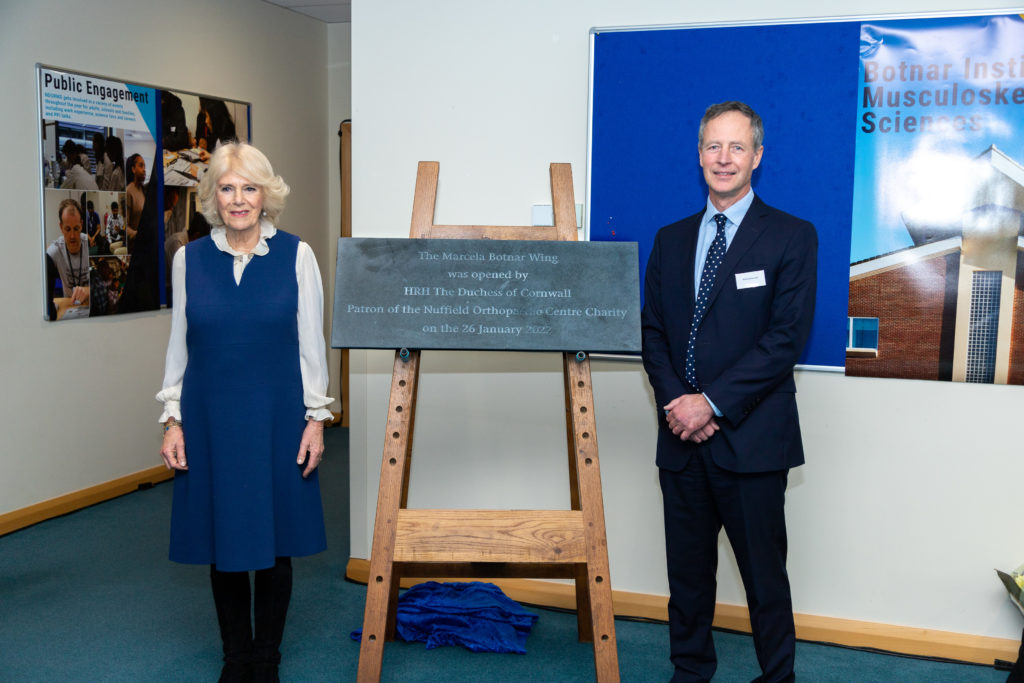A new building at the University of Oxford’s Botnar Institute for Musculoskeletal Sciences has been opened by The Duchess of Cornwall.

The Botnar Institute for Musculoskeletal Sciences, on the site of the Nuffield Orthopaedic Centre (NOC), carries out research, much of it supported by the NIHR Oxford Biomedical Research Centre, into improving the treatment of arthritis, osteoporosis and other bone and joint diseases.
The Institute works in close partnership with the NOC, part of Oxford University Hospitals NHS Foundation Trust, ensuring its research is closely tied to patient care in the hospital.
The new Marcella Botnar wing will focus on bioengineering, with researchers working on developing new technologies, materials, and interventions to treat patients with musculoskeletal conditions.
The Duchess of Cornwall is Patron of the Nuffield Orthopaedic Centre (NOC) Charity, which raised £9 million for the new building.
The Duchess toured the new facility, which includes the first university-owned clean room in the UK, and was shown how synthetic biomaterials such as biopatches and bioyarns, for use in tissue repair, will be made in a sterile environment.
Professor Constantin Coussios, Director of the University’s Institute of Biomedical Engineering, demonstrated a new technology that enableshuman organs to be kept alive and functioning outside the body for periods of several days. Developed by researchers collaborating across biomedical engineering and surgery, the technology has increased the number of organs viable for transplant by 30 per cent.
In another example of the institute’s work, Eleanor Stride, Professor of Biomaterials, talked about antimicrobial resistance. She explained her new project to reduce our reliance on conventional antibiotics which involves using ultrasound to drive drug molecules into infected cells to kill the bacteria.
Professor Sir John Bell, Regius Professor of Medicine, said: “A real highlight of Oxford biomedicine is that it brings together surgeons, physicians, cell biologists, geneticists, structural biologists, and now increasingly engineers and people from the physical sciences. And if you get all those people working together, watch out because really exciting things are going to happen. So, on behalf of the University I could not be more proud of what the team has done, and we look forward to a very exciting future.”
The new wing marks the third phase of the Botnar Institute for Musculoskeletal Sciences, part of the Nuffield Department of Orthopaedics, Rheumatology and Musculoskeletal Sciences (NDORMS). The Duchess of Cornwall opened the Botnar’s other buildings in 2003 and 2014. The three buildings together will house around 500 University researchers, many of them supported by the Oxford BRC.
Professor Jonathan Rees, Director of the Botnar Institute for Musculoskeletal Sciences said: “We are so grateful that The Duchess of Cornwall was able to come and open our third wing today. This marks an important stage for us as we build further research capacity and welcome our new bio-engineering colleagues to our team of researchers in the Botnar. This will allow us to drive forward with our vision of multidisciplinary research to discover new innovative treatments for the many patients in the UK and around the world suffering with bone and joint disease.”
Professor Andrew Carr, Head of Department at NDORMS and Theme Lead for the Oxford BRC’s Musculoskeletal Theme, said: “We are delighted that The Duchess of Cornwall was able to come and visit our Institute again. There is a great need for improved treatments for the many people whose quality of life is reduced by conditions such as arthritis, osteoporosis and other types of inflammatory diseases.
“Our position on the site of the NOC has brought the University’s bone, joint and arthritis research and teaching together with clinical practice at the hospital, with many patients participating in research projects and clinical studies. This new wing will enhance our existing link with engineering and enable us to be at the forefront of technical innovations in medicine to tackle the large burden of disease, pain and disability and make a real difference to people’s lives.”
At a reception for guests, sponsors, donors and researchers, the Duchess of Cornwall said: “I just wanted to congratulate everybody involved. Every time I come to the Botnar, I have forgotten just how good it is with all the incredible research and things that are going on. Some of the things I have seen today I just wouldn’t have believed unless I’d seen it with my own eyes. Thank you so much for having me here again.”
A speech was read on behalf of Rt. Hon. Lord Tebbit CH, President of the Nuffield Orthopaedic Centre Appeal, who said: “Countless individuals in the NOC Charity, the University, and the hospitals have given their time and skills to make the project possible and we wish to thank them all. And to emphasise none of this would have been possible without the help of the Botnar Family. Above all thank you, your Royal Highness, for your time and commitment as our Patron and for your unstinting support for osteoporosis and other bone and joint disease research.”